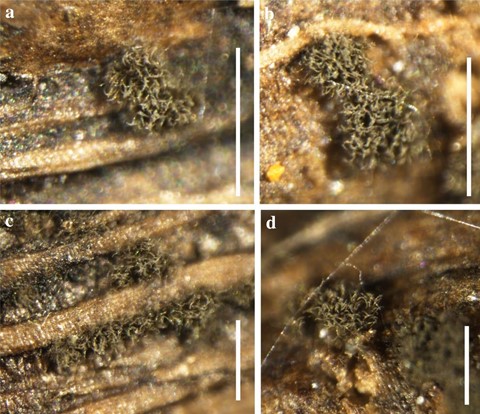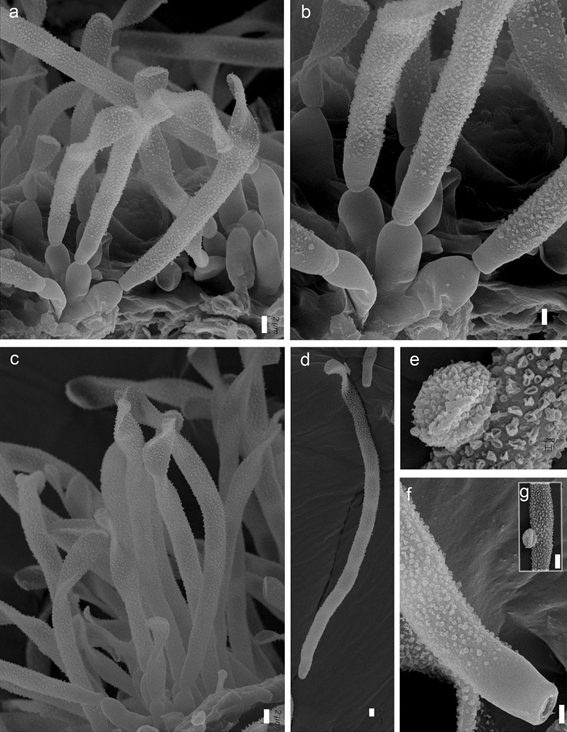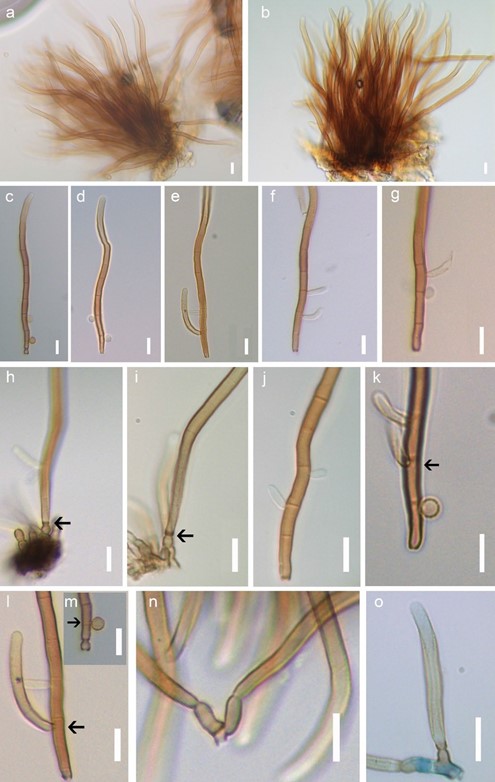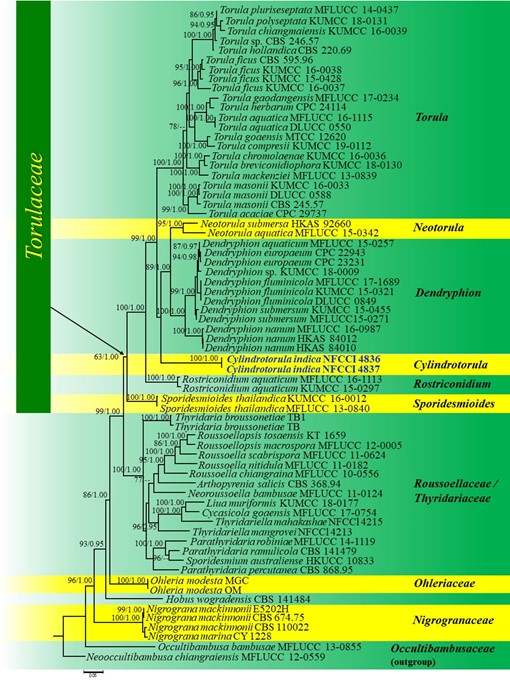Cylindrotorula Rajeshkumar, Wijayaw. & Bhat, gen. nov.
Index Fungorum number: IF557635; Facesoffungi number: FoF 08026
Etymology: Named after cylindrical, elongated, verrucu- lose primary conidia, and conidial ornamentations similar to Torula species.
Holotype: AMH 10228
Saprobic on decaying Cocos nucifera spathe.
Sexual morph: Undetermined.
Asexual morph: Hyphomycetous. Conidiomata sporodochial, scattered, greyish, dark greyish brown or dark brown. Conidiophores micronematous, mon- onematous, reduced, cylindrical, smooth, erect, unbranched or rarely branched. Conidiogenous cells cylindrical or but- ton-shaped, produce primary and secondary conidia. Pri- mary conidia arising holoblastically, elongated, cylindrical, wavy or undulated or flexuous, smooth at base, verrucose above, pale to dark brown, unbranched, phragmo-septate. Secondary conidia two types, globose and cylindrical, ver- rucose or smooth, arising from primary conidia from inter- calary, monotretic, non-cicatrized conidiogenous loci just below septa; cylindrical or finger shaped conidia slightly curved, aseptate, thin-walled, brown.
Type species: Cylindrotorula indica Rajeshkumar, Wijayaw., Bhat, N. Ashtekar & S. Lad
Notes: – The proposed new genus Cylindrotorula is simi- lar to Alcornia, Parapericonia and Sporotretospora (Ellis 1976; Monteiro et al. 2017; Whitton et al. 2012). All these genera have been described solely on morphology and are yet to be investigated based on DNA sequence analyses. The conidiophores in Alcornia and Parapericonia are illus- trated and interpreted as elongated, verruculose, flexuous and with a distinct basal constriction or zone of weakness. Sporotretophora and Alcornia are similar in arrangement of conidiophores, enteroblastic tretic conidiogenesis, and unicelled conidia, but Sporotretophora has monotretic con- idiogenous cells and schizolytic secession of conidia (Whit- ton et al. 2012). A detailed micro-morphological study of Cylindroturula on natural substrates using SEM and com- pound microscopy revealed its holoblastic development of cylindrical, elongated, flexuous, verrucose primary conidia from a reduced, sporodochial, micronematous, mononema- tous, septate, branched, or unbranched, erect conidiophores having an apical cylindrical or button-shaped conidioge- nous cells (Figs. 73, 74 and 75). Secondary conidia develop monotretic and are of two types, (1) globose, verruculose, brown to dark brown and (2) finger-shaped or narrow cylin- drical, thin-walled, smooth to minutely verrucose, with an obtuse tip and truncate base.
The monotretic, secondary conidial development seg- regates Cylindrotorula from the Parapericonia. Whereas monotretic to polytretic globose conidia with an integrated, rhexolytic, verruculose ornamentation is the key distinguish- ing character in Alcornia. The narrowly cylindrical, curved, thin-walled secondary conidia having monotretic conidial ontogeny seen in Cylindrotorula is absent in Alcornia, Par- apericonia and Sporotretophora. A BLASTn search using ITS, LSU, RPB2 and TEF1-α sequence data in NCBI has shown about 90% similarity of the query sequences to Den- dryphion and Neotorula strains. Dendryphion is character- ized by polytretic conidiogenous cells with pores encircled by dark scars, and chains of brown, septate (didymo- or cheiro) conidia (Crous et al. 2014a). The phylogenetic anal- yses based on ITS, LSU, RPB2 and TEF1-α sequence data also formed a well-supported (100% MLBS, 1.00 BYPP; Fig. 76) independent sister lineage sister to Neotorula and Dendryphion within Torulaceae. Thus, based on morpho- logical characteristics and phylogenetic analyses, we accom- modate Cylindrotorula as new genus with the type species C. indica.

Fig. 73 Cylindrotorula indica (AMH 10228, holotype). a–d Sporodochial conidiomata on natural substrate. Scale bars: a–d = 100 µm

Fig. 74 Cylindrotorula indica (AMH 10228, holotype). a–c SEM of conidiomata showing conidiophores and primary conidia. d Cylin- drical elongated primary conidium. e Globose secondary conidium. f Base of primary conidium. g Secondary conidial development of primary conidia. Scale bars: a, c, d, g = 2 µm, b = 1 µm, e = 200 nm, f = 1 µm

Fig. 75 Cylindrotorula indica (AMH 10228, holotype). a, b Sporo- dochial conidiomata. c–g Primary conidia with monotretic secondary conidia. h, i Dark thick hilum of primary conidia. j, k Pleomorphic secondary conidia. l, m Monotretic secondary conidial develop- ment. n, o Branched conidiophore with primary conidia. Scale bars: a–o = 10 µm

Fig. 76 Phylogram generated from maximum likelihood analysis based on LSU, RPB2, ITS, and TEF1-α sequence dataset representing Torulaceae and related families. Related sequences are taken from Hyde et al. (2019). Sixty-eight strains are included in the combined analyses which comprise 2807 characters and 517 characters for ITS after alignment. Neooccultibambusa chiangraiensis (MFLUCC 12-0559) and Occultibambusa bambusae (MFLUCC 12-0559) in Occultibambusaceae (Pleosporales) are used as the outgroup taxa. Single gene analyses were also performed to compare the topology and clade stability with combined gene analyses. Tree topology of the maximum likelihood analysis is similar to the Bayesian analysis. The best RAxML tree with a final likelihood values of − 25944.916075 is presented. The matrix had 1201 distinct alignment patterns, with 23.66% undetermined characters or gaps. Estimated base frequen- cies were as follows: A = 0.240116, C = 0.269729, G = 0.272735, T = 0.217421; substitution rates AC = 1.567160, AG = 3.410853, AT = 1.595585, CG = 0.809155, CT = 7.747008, GT = 1.000000;
gamma distribution shape parameter α = 0.645809. Bootstrap values for maximum likelihood (MLBS) equal to or greater than 60% and posterior probabilities (BYPP, right) equal to or greater than 0.95 (the rounding of values to 2 decimal places) from Bayesian inference anal- ysis labeled on the nodes. The newly generated sequences are in blue bold
Species
